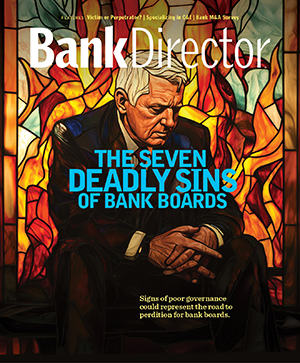
Three Secrets to Running a High Performance Bank

Having gone through this exercise a number of times now, I can make three observations about what the ranking reveals. First, it tends to favor banks that are well balanced across all of the performance metrics rather than dominating just one of them. One of the built-in tensions in this ranking is between return on average equity (ROAE), which measures a company’s effective use of investor capital, and capitalization itself, using the ratio of tangible common equity (TCE) to tangible assets. The higher your bank’s TCE ratio, the more difficult it becomes to also post a high ROAE. The reason is simple math: Return on equity is calculated by dividing net income (the numerator) by shareholder equity (the denominator). All things being equal, the higher the denominator (shareholder equity), the higher the numerator (net income) has to be to produce the same result.
Clearly, banks that are able to generate a high level of profitability on a strong capital base have an advantage in our ranking. And a perfect example is $6.7 billion asset Bank of the Ozarks Inc. in Little Rock, Arkansas, which placed first in the $5 billion to $50 billion category. Ozarks had the third best ROAE out of the 102 banks in its asset category—but also the 12th best TCE ratio—which is an extremely powerful combination.
A second observation is that a core group of banks seem to score well on the ranking year after year. With $92.8 billion in assets, Cleveland-based KeyCorp placed second in the $50 billion and above category this year, and fourth in 2013 and 2014. Ozarks placed first in the $1 billion to $5 billion category in 2013 and 2014, then moved up to the midsize $5 billion to $50 billion category in 2015 following a spate of acquisitions—where it won again, edging out Abilene, Texas-based First Financial Corp. by 1.5 points in the final ranking. This was no small accomplishment because First Financial was the top ranked midsize bank in 2014, and previously dominated the $1 billion to $5 billion category going back to 2009.
When a group of banks perform at such a consistently high level (and there are other banks that I could highlight as well), they invariably benefit from strong executive leadership—and that is certainly true in this case. Beth Mooney at KeyCorp, George Gleason at Bank of the Ozarks and Scott Dueser at First Financial are among the banking industry’s most accomplished CEOs, and they are backed by first rate management teams. It is an obvious but inescapable truth that sustaining a high level of profitability in such a competitive industry like banking is exceedingly difficult without talented leadership.
But just having good managers isn’t enough. You also need to have a good business plan, and the third observation that I would make is that the banks that perform well on the Scorecard have well developed strategies that set them apart from their peers. Most banking products tend to be commodities that are available at any number of bank and nonbank providers. Although they are very different, the three category winners in 2015 all benefited from strategic focus. Capital One Financial Corp., the winner of the $50 billion-plus category, has a large credit card operation that helps drive its profitability. Ozarks’ profitability was driven by an ambitious nationwide commercial real estate lending business, as well as an active mergers and acquisition program. And the top ranked bank in the $1 billion to $5 billion category, $2 billion asset Preferred Bank, which is headquartered in Los Angeles, focuses almost exclusively on businesses and wealthy individuals in that market.
Being all things to all people might be a winning strategy in politics, but it rarely succeeds in banking.



